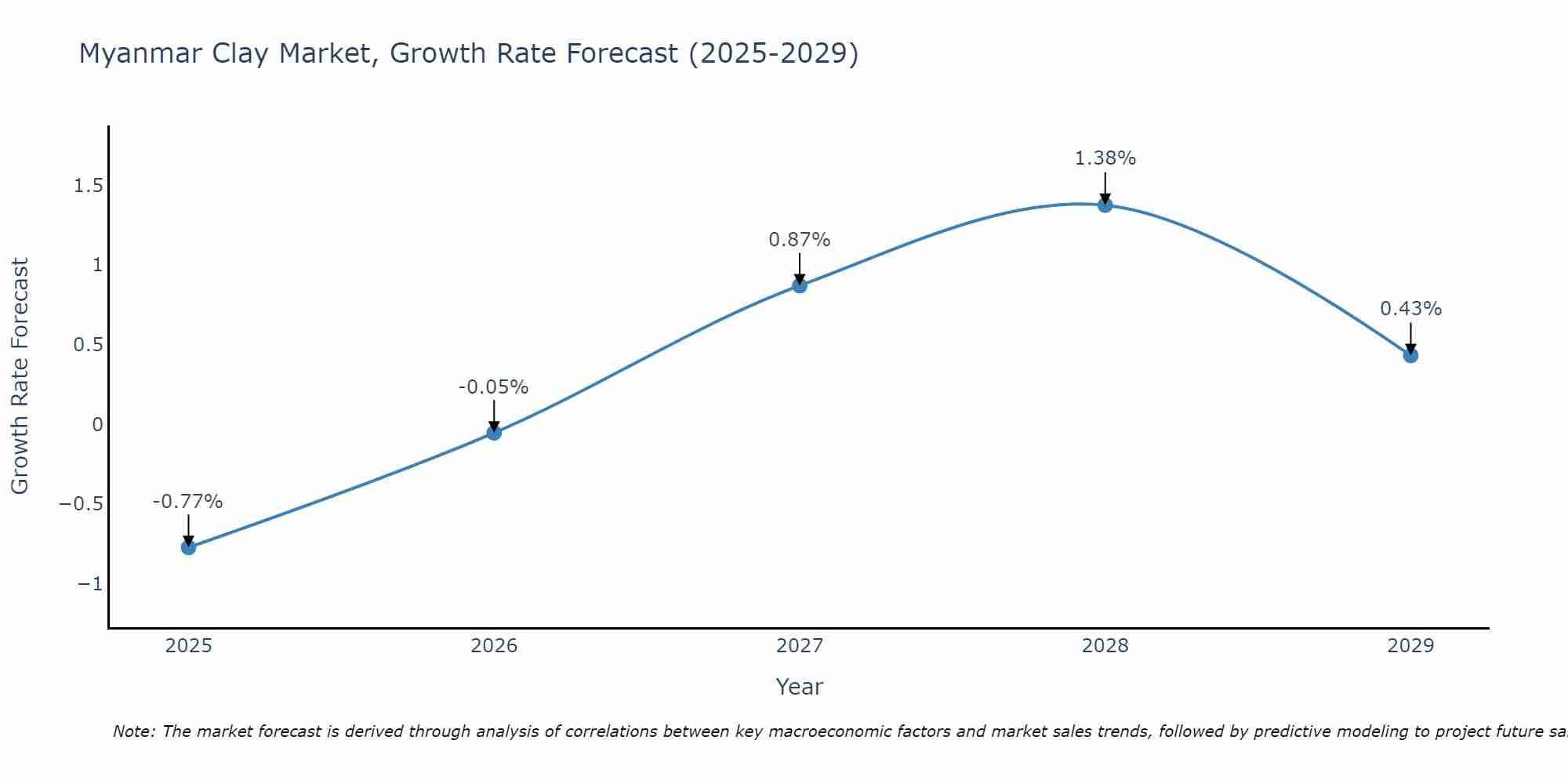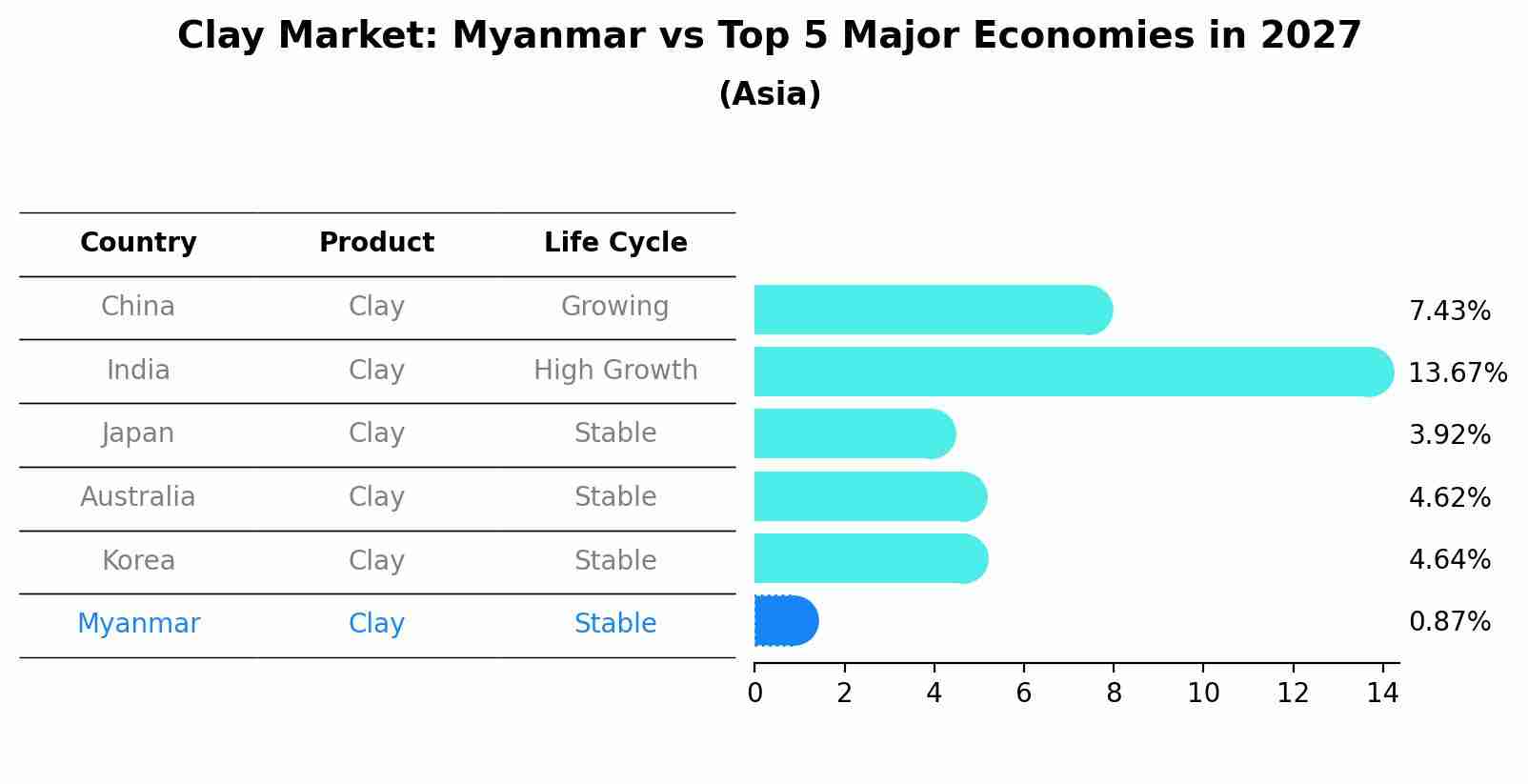Myanmar Clay Market (2025-2031) Outlook | Forecast, Revenue, Trends, Industry, Share, Analysis, Growth, Size, Companies & Value
| Product Code: ETC318994 | Publication Date: Aug 2022 | Updated Date: Aug 2025 | Product Type: Market Research Report | |
| Publisher: 6Wresearch | Author: Shubham Padhi | No. of Pages: 75 | No. of Figures: 35 | No. of Tables: 20 |
Myanmar Clay Market Size Growth Rate
The Myanmar Clay Market is projected to witness mixed growth rate patterns during 2025 to 2029. The growth rate begins at -0.77% in 2025, climbs to a high of 1.38% in 2028, and moderates to 0.43% by 2029.

Clay Market: Myanmar vs Top 5 Major Economies in 2027 (Asia)
The Clay market in Myanmar is projected to grow at a stable growth rate of 0.87% by 2027, within the Asia region led by China, along with other countries like India, Japan, Australia and South Korea, collectively shaping a dynamic and evolving market environment driven by innovation and increasing adoption of emerging technologies.

Myanmar Clay Market Overview
Myanmar clay market is significant due to its applications in construction, ceramics, and pottery. The abundance of natural clay deposits in the country provides a steady supply for domestic use and export. The construction boom, fueled by urbanization and infrastructure development, drives the demand for clay products. Additionally, traditional crafts and the burgeoning ceramics industry contribute to the market`s growth.
Drivers of the market
The clay market in Myanmar is primarily driven by the growth of the construction and ceramics industries. Clay is extensively used in the production of bricks, tiles, and ceramics, which are essential materials in construction activities. The increasing urbanization and infrastructure development in Myanmar boost the demand for construction materials, thereby driving the clay market. Additionally, the rising popularity of traditional and handcrafted pottery products supports the growth of the ceramics industry. The expanding agriculture sector also contributes to market growth, as clay is used in soil conditioning and as a natural pesticide. The availability of high-quality clay deposits in Myanmar further supports market expansion.
Challenges of the market
The Myanmar Clay Market is challenged by inefficient mining practices and the lack of advanced processing technologies. The extraction and processing of clay are often done using outdated methods, resulting in lower quality and reduced marketability of the final products. Additionally, there are environmental concerns and regulatory issues that complicate mining operations. The market also suffers from inadequate infrastructure for transportation and distribution, which affects the timely delivery and availability of clay products.
Government Policy of the market
The government of Myanmar is supporting the clay industry by encouraging both traditional and industrial applications of clay. Policies include providing grants for small-scale pottery businesses, facilitating the modernization of brick and tile manufacturing units, and promoting the export of high-quality clay products. Environmental regulations are also being enforced to ensure sustainable clay mining practices.
Key Highlights of the Report:
- Myanmar Clay Market Outlook
- Market Size of Myanmar Clay Market, 2024
- Forecast of Myanmar Clay Market, 2031
- Historical Data and Forecast of Myanmar Clay Revenues & Volume for the Period 2021-2031
- Myanmar Clay Market Trend Evolution
- Myanmar Clay Market Drivers and Challenges
- Myanmar Clay Price Trends
- Myanmar Clay Porter's Five Forces
- Myanmar Clay Industry Life Cycle
- Historical Data and Forecast of Myanmar Clay Market Revenues & Volume By Application for the Period 2021-2031
- Historical Data and Forecast of Myanmar Clay Market Revenues & Volume By Tableware for the Period 2021-2031
- Historical Data and Forecast of Myanmar Clay Market Revenues & Volume By Sanitary ware for the Period 2021-2031
- Historical Data and Forecast of Myanmar Clay Market Revenues & Volume By Medical applications for the Period 2021-2031
- Historical Data and Forecast of Myanmar Clay Market Revenues & Volume By End Use for the Period 2021-2031
- Historical Data and Forecast of Myanmar Clay Market Revenues & Volume By Ceramic and for the Period 2021-2031
- Historical Data and Forecast of Myanmar Clay Market Revenues & Volume By Non-ceramic for the Period 2021-2031
- Myanmar Clay Import Export Trade Statistics
- Market Opportunity Assessment By Application
- Market Opportunity Assessment By End Use
- Myanmar Clay Top Companies Market Share
- Myanmar Clay Competitive Benchmarking By Technical and Operational Parameters
- Myanmar Clay Company Profiles
- Myanmar Clay Key Strategic Recommendations
Frequently Asked Questions About the Market Study (FAQs):
1 Executive Summary |
2 Introduction |
2.1 Key Highlights of the Report |
2.2 Report Description |
2.3 Market Scope & Segmentation |
2.4 Research Methodology |
2.5 Assumptions |
3 Myanmar Clay Market Overview |
3.1 Myanmar Country Macro Economic Indicators |
3.2 Myanmar Clay Market Revenues & Volume, 2021 & 2031F |
3.3 Myanmar Clay Market - Industry Life Cycle |
3.4 Myanmar Clay Market - Porter's Five Forces |
3.5 Myanmar Clay Market Revenues & Volume Share, By Application, 2021 & 2031F |
3.6 Myanmar Clay Market Revenues & Volume Share, By End Use, 2021 & 2031F |
4 Myanmar Clay Market Dynamics |
4.1 Impact Analysis |
4.2 Market Drivers |
4.2.1 Growth in construction and infrastructure development projects in Myanmar |
4.2.2 Increasing demand for clay products in the manufacturing industry |
4.2.3 Favorable government policies supporting the clay industry in Myanmar |
4.3 Market Restraints |
4.3.1 Fluctuations in raw material prices impacting production costs |
4.3.2 Competition from alternative materials like concrete and plastics |
4.3.3 Environmental concerns related to clay mining and processing in Myanmar |
5 Myanmar Clay Market Trends |
6 Myanmar Clay Market, By Types |
6.1 Myanmar Clay Market, By Application |
6.1.1 Overview and Analysis |
6.1.2 Myanmar Clay Market Revenues & Volume, By Application, 2021-2031F |
6.1.3 Myanmar Clay Market Revenues & Volume, By Tableware, 2021-2031F |
6.1.4 Myanmar Clay Market Revenues & Volume, By Sanitary ware, 2021-2031F |
6.1.5 Myanmar Clay Market Revenues & Volume, By Medical applications, 2021-2031F |
6.2 Myanmar Clay Market, By End Use |
6.2.1 Overview and Analysis |
6.2.2 Myanmar Clay Market Revenues & Volume, By Ceramic and, 2021-2031F |
6.2.3 Myanmar Clay Market Revenues & Volume, By Non-ceramic, 2021-2031F |
7 Myanmar Clay Market Import-Export Trade Statistics |
7.1 Myanmar Clay Market Export to Major Countries |
7.2 Myanmar Clay Market Imports from Major Countries |
8 Myanmar Clay Market Key Performance Indicators |
8.1 Percentage increase in demand for clay products in Myanmar year-over-year |
8.2 Adoption rate of innovative clay processing technologies in the market |
8.3 Number of new clay product developments and applications introduced in the market |
9 Myanmar Clay Market - Opportunity Assessment |
9.1 Myanmar Clay Market Opportunity Assessment, By Application, 2021 & 2031F |
9.2 Myanmar Clay Market Opportunity Assessment, By End Use, 2021 & 2031F |
10 Myanmar Clay Market - Competitive Landscape |
10.1 Myanmar Clay Market Revenue Share, By Companies, 2024 |
10.2 Myanmar Clay Market Competitive Benchmarking, By Operating and Technical Parameters |
11 Company Profiles |
12 Recommendations |
13 Disclaimer |
- Single User License$ 1,995
- Department License$ 2,400
- Site License$ 3,120
- Global License$ 3,795
Search
Related Reports
- ASEAN and Thailand Brain Health Supplements Market (2025-2031) | Strategy, Consumer Insights, Analysis, Investment Trends, Opportunities, Growth, Size, Share, Industry, Revenue, Segments, Value, Segmentation, Supply, Forecast, Restraints, Outlook, Competition, Drivers, Trends, Demand, Pricing Analysis, Competitive, Strategic Insights, Companies, Challenges
- ASEAN Bearings Market (2025-2031) | Strategy, Consumer Insights, Analysis, Investment Trends, Opportunities, Growth, Size, Share, Industry, Revenue, Segments, Value, Segmentation, Supply, Forecast, Restraints, Outlook, Competition, Drivers, Trends, Demand, Pricing Analysis, Competitive, Strategic Insights, Companies, Challenges
- Europe Flooring Market (2025-2031) | Outlook, Share, Industry, Trends, Forecast, Companies, Revenue, Size, Analysis, Growth & Value
- Saudi Arabia Manlift Market (2025-2031) | Outlook, Size, Growth, Trends, Companies, Industry, Revenue, Value, Share, Forecast & Analysis
- Uganda Excavator, Crane, and Wheel Loaders Market (2025-2031) | Strategy, Consumer Insights, Analysis, Investment Trends, Opportunities, Growth, Size, Share, Industry, Revenue, Segments, Value, Segmentation, Supply, Forecast, Restraints, Outlook, Competition, Drivers, Trends, Demand, Pricing Analysis, Competitive, Strategic Insights, Companies, Challenges
- Rwanda Excavator, Crane, and Wheel Loaders Market (2025-2031) | Strategy, Consumer Insights, Analysis, Investment Trends, Opportunities, Growth, Size, Share, Industry, Revenue, Segments, Value, Segmentation, Supply, Forecast, Restraints, Outlook, Competition, Drivers, Trends, Demand, Pricing Analysis, Competitive, Strategic Insights, Companies, Challenges
- Kenya Excavator, Crane, and Wheel Loaders Market (2025-2031) | Strategy, Consumer Insights, Analysis, Investment Trends, Opportunities, Growth, Size, Share, Industry, Revenue, Segments, Value, Segmentation, Supply, Forecast, Restraints, Outlook, Competition, Drivers, Trends, Demand, Pricing Analysis, Competitive, Strategic Insights, Companies, Challenges
- Angola Excavator, Crane, and Wheel Loaders Market (2025-2031) | Strategy, Consumer Insights, Analysis, Investment Trends, Opportunities, Growth, Size, Share, Industry, Revenue, Segments, Value, Segmentation, Supply, Forecast, Restraints, Outlook, Competition, Drivers, Trends, Demand, Pricing Analysis, Competitive, Strategic Insights, Companies, Challenges
- Israel Intelligent Transport System Market (2025-2031) | Strategy, Consumer Insights, Analysis, Investment Trends, Opportunities, Growth, Size, Share, Industry, Revenue, Segments, Value, Segmentation, Supply, Forecast, Restraints, Outlook, Competition, Drivers, Trends, Demand, Pricing Analysis, Competitive, Strategic Insights, Companies, Challenges
- Uganda Precast and Aggregate Market (2025-2031) | Strategy, Consumer Insights, Analysis, Investment Trends, Opportunities, Growth, Size, Share, Industry, Revenue, Segments, Value, Segmentation, Supply, Forecast, Restraints, Outlook, Competition, Drivers, Trends, Demand, Pricing Analysis, Competitive, Strategic Insights, Companies, Challenges
Industry Events and Analyst Meet
Our Clients
Whitepaper
- Middle East & Africa Commercial Security Market Click here to view more.
- Middle East & Africa Fire Safety Systems & Equipment Market Click here to view more.
- GCC Drone Market Click here to view more.
- Middle East Lighting Fixture Market Click here to view more.
- GCC Physical & Perimeter Security Market Click here to view more.
6WResearch In News
- Doha a strategic location for EV manufacturing hub: IPA Qatar
- Demand for luxury TVs surging in the GCC, says Samsung
- Empowering Growth: The Thriving Journey of Bangladesh’s Cable Industry
- Demand for luxury TVs surging in the GCC, says Samsung
- Video call with a traditional healer? Once unthinkable, it’s now common in South Africa
- Intelligent Buildings To Smooth GCC’s Path To Net Zero













